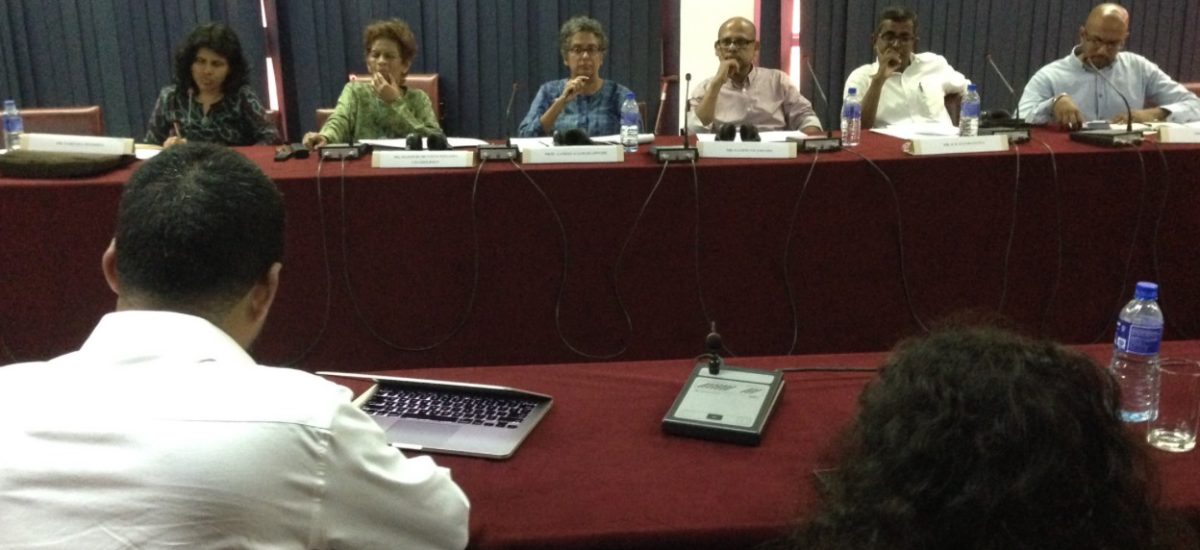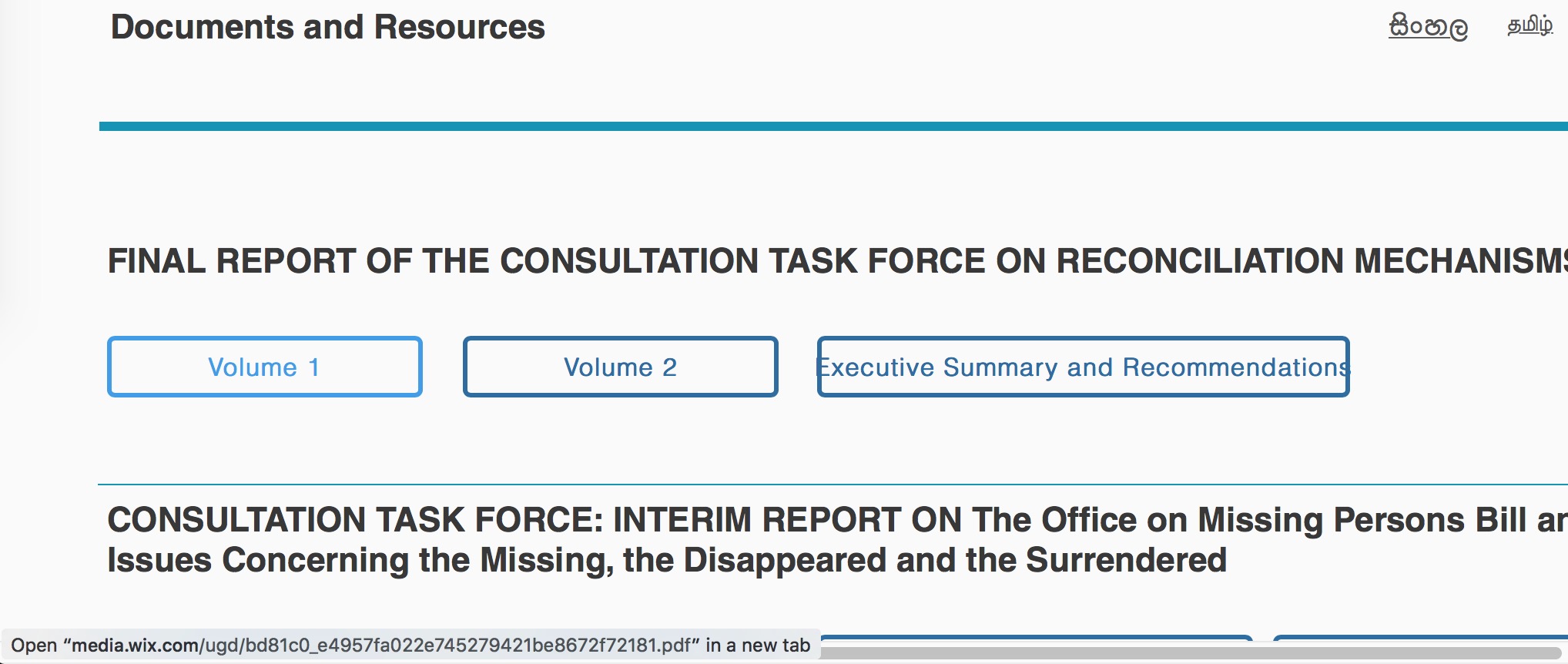Image courtesy Consultation Task Force, featuring submission by Groundviews to it. Details here.
After months of waiting, the final report of the Consultation Task Force, set up by the Prime Minister in January 2016, was released to the public in the early hours of 4th January 2016. An event to present the report to the President and the Prime Minister was held the previous day. Neither the President nor the Prime Minister attended. Much can be written about the optics of this fact alone, but this post is anchored to the manner in which the Secretariat for Coordinating Reconciliation Mechanisms (SCRM), now the custodian of the report, went about releasing it to the public domain.
Since its inception, a coherent communications strategy and any competency around it at SCRM have both remained good ideas. At around 2.30am on the morning of the 4th, when the CTF published links to the report and supporting documentation, there existed two versions of the content. One, on the SCRM website. The other, as tweeted and promoted by the CTF itself. Substantively, the reports were identical. The differences were around how the PDFs were created.
The CTFs PDFs were extremely large. Looking at the metadata, it was evident that they were created from JPG images, perhaps to ensure that no one could highlight and copy any text from the resulting PDFs. This in turn made the PDFs rather useless for researchers, journalists, historians and others, who rely on the ability to search within a PDF in order to get to, flag, extrapolate and use substantive content in their own output, research and articles. In addition, the sheer size of the PDFs meant that they were impossible to email, read on a mobile device or share.
At around the same time, the SCRM’s website had links to the report that were created from Word, using the PDF creation feature bundled into MacOS. The screenshot above, taken from the version of the webpage active at the time, clearly shows the link to the PDF hosted on the SCRM’s website itself. While identical in substance to the CTF’s reports, major advantages of these files were that they were really small, fully searchable, easily shareable and basically ideal for researchers, journalists and others to use in order to really drill down into the substantive matter in the reports.
The difference in file sizes alone was significant. For example, the CTF version of the Executive Summary was over 90 times greater in size than the SCRM’s version, at the time.
Groundviews alerted CTF around this anomaly, and also mirrored the smaller versions of the files, taken off the SCRM website, on our own Google Drive folder. We created an easy to remember short link using Bit.ly (bit.ly/CTF-FinalReport). We shared this on Twitter, on CTF’s Facebook page and on our WhatsApp group, followed by many around the world who were keenly awaiting the release of this content.
A mirror of the @officialscrmsl versions of the #pubconsl report + supporting docs is now at https://t.co/xS3LsulshF @ctfsl #lka #srilanka
— Groundviews (@groundviews) January 3, 2017
By around 7am this morning, SCRM’s website had deleted the direct links to the PDFs and instead now pointed to a Google Drive folder it had created. In an inexplicable move, this Google Drive folder features the same versions of the reports shared earlier by CTF. In essence, this makes it much harder to engage with the CTF’s output and ensures that no search engine on the web, or PDF reader locally, will ever be able to index the content in these reports.
Adding to this confusion was the way in which the Google Drive folder by SCRM was configured. The folder had been created by someone called Mushtak Ahamed just before midnight. Just after midnight, permission to see the files in the folder had then been extended to key staff of SCRM and the CTF. By 1.01am, with the Executive Summary for example, Mr. Ahamed gives Nigel Nugawela, former co-editor of Groundviews and researcher with the CTF, permission to edit the file and folder. Mr. Nugawela, rightly, then changes the permission level of the file to view only, and for anyone from the scrm.gov.lk domain. At 1.04am, Mr. Ahamed, for some inexplicable reason, changes the permission of the file back to edit for anyone within the scrm.gov.lk. But more egregiously, just a minute after, at 1.05am, Mr. Ahamed changes the permission of the folder and file to allow anyone, from anywhere, as long as they are logged into Gmail or Google, to edit the folder and file.
And this is exactly what we did just past 7.20am this morning.
The erroneously configured Google Drive folder by Secretariat for Coordinating Reconciliation Mechanismswhich led to, on the morning of 4th January 2016, anyone being able to delete the content or add to the folder any content of their own. The original content was the final reports from the Consultation Task Force on Reconciliation Mechanisms.
Posted by Groundviews on Tuesday, January 3, 2017
Groundviews deleted all three official versions of the reports, added a text file from our desktop, then restored the official versions of the report and deleted the file we added.
We immediately wrote to the CTF regarding this, noting that “Anyone, at any time, can delete the official reports off the SCRM’s Google Drive folder, or at their discretion, add anything from pornography to their family photos to this folder”. At the time of writing, and possibly as a result of our email, the links from the SCRM webpage to their Google Drive folder are dysfunctional.
And there you have it. You would think the launch of a report in 2017 would be a simple affair. Questions around the technical competency of government arose at the launch event itself, which no media were allowed to cover.
Or live streaming. Or recording. Or any documenting for posterity basically. Sad. #lka #srilanka https://t.co/AR3chC7sQP
— Groundviews (@groundviews) January 3, 2017
The reason, when CTF had inquired, was that the President’s Media Division didn’t allow live-streaming of events.
@groundviews I asked if @officialscrmsl could livestream event. Apparently @PMDNewsGov wouldn't allow it. Archaic, suspicious & inflexible
— N. V. Nugawela (@n_v_nugawela) January 3, 2017
This is then followed up by an absolute fiasco by the SCRM in releasing the report. First having two versions of it. Then promoting a version which is by far the most user-unfriendly, unwieldy and hardest to engage with. Following this up with a Google Drive folder that allowed anyone to mess around with the content in it. And finally, at the time of writing, a webpage that does not in fact have any functioning link to the official reports.
Leaving aside the non-participation of the President and Prime Minister at the launch of the report, the sheer incompetency in just putting it online is indicative of how the worst qualified remain those in charge of implementation. If the PDFs of a national level consultative report can’t be uploaded in a coherent manner, what hope is there around the competency of the SCRM in particular, and government writ large, in implementing any of the technical recommendations in the CTF’s report?



